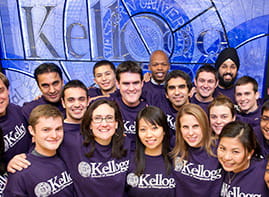10/20/2014 - While serving as the General Manager for one of the world’s largest floral wire-service companies, Richard Lim ’10 developed close relationships — friendships, even — with his flower distributors. So when one of those distributors found out that Lim was engaged, he offered to supply all of the wedding flowers for free.
Lim excitedly shared the news with his fiancée. “But then we said, ‘Wait a minute,’” he recalls. “What are we going to do with all of these flowers? How are we going to arrange them? What type of flower should we use?’” Overwhelmed by the process, Lim turned down the offer, instead hiring a florist for $2,500 to create all of the centerpieces and bouquets for him.
Costs aside, that decision served Lim well: It inspired him to co-found a company that supplies the tools and materials to create do-it-yourself floral arrangements for weddings or other events.
A blooming business
Earlier this year, Lim partnered up with Dallas-based entrepreneur Songhua Hu ’10 to launch
Bloominous in Lim’s hometown of Los Angeles.
The company aims to capitalize on the “DIY” trend while loosely emulating the IKEA business model. Brides and grooms visit the Bloominous website to choose from an assortment of design collections (with varying themes such as Vintage Cottage, Bohemian Desert and Country Charm) and indicate the number of centerpieces, bouquets, boutonnèires and corsages they need for the big day. A few days before the wedding, Bloominous preps, packages and airmails the flowers direct to the customer, along with step-by-step instructions, pins, ribbons, vases and other supplies to assemble each piece in 15 minutes or less.
The entire order costs about half of what a floral shop might charge.
Backed by angel investors, Bloominous is now regularly securing orders in the $500 to $800 range and posting “double-digit growth,” says Lim, though he doesn’t disclose actual figures. Since early July, the company has appeared in more than 150 blogs and the number of unique visitors to the website tripled between June and July.
“Every indication is telling us that we are on the right track,” he says. “Our customers have emailed us to say, ‘This is such a great concept. I was looking for something like this and I found you guys’ or ‘Where was this when I was getting married – At least I get to use you for my baby shower’. It’s very encouraging to see our customers be our biggest advocate.”
Partners in time
A key factor behind Bloominous’ success is the complementary strengths of its founders. Lim used his industry knowledge and relationships with distributors in California and South America to build and manage Bloominous’ operations. Hu, a self-described “scrappy entrepreneur," used his problem-solving skills and experience working at Google and McKinsey to address Bloominous’ technology and marketing needs.
“From an execution standpoint, there are certain things that I can do and certain things that Songhua can do,” says Lim, who added that the pair works together remotely because Hu is based in Dallas. “We divide up the roles so that we’re responsible for each part of the business.”
Lim and Hu met while they were still students at Kellogg, where they developed “a sense of wanting to be an entrepreneur,” says Hu. After graduation, both took full-time jobs but met several times a week to brainstorm ideas for startups. Over time, their list of ideas grew to 50.
To pinpoint a winning idea, Lim remembered some advice he received from a Kellogg alumnus. “He said that you need two of three things to be successful in an entrepreneurial endeavor: You need passion. You need insider knowledge of an industry. And you need the right timing.” Bloominous hit all three points.
Venturing further
But another idea showed promise, one inspired by an ‘aha’ moment that Hu experienced while trying to find renters for his Chicago condo in 2012.
Hu realized that most landlords use credit reports to screen prospective tenants. But his work as a senior associate for Enova Financial taught him better. “A credit report tells you about someone’s past, but it doesn’t say anything about that person’s ability to pay a loan,” Hu explains. “You have to screen for employment and income.”
So in January 2013, Hu and Lim co-founded Tenantify, a website that verifies prospective renters’ employment and income on behalf of landlords. Hu took the lead on this project, teaching himself coding and using his knowledge of income-screening practices to build the online platform.
While Hu cautions that the company is still “ramen noodle profitable” — just making enough to cover costs, living expenses and cheap noodles — its revenue has increased by 75 percent between June and July. Currently, Tenantify relies on word-of-mouth and SEO marketing to recruit new customers, but Lim is exploring partnerships with management companies and larger groups to scale the business.
Slow and steady growth is part of Hu’s vision for Tenantify, which is also why he and Lim bootstrapped the business themselves. “I’m leaning toward not funding at all and growing organically so we can reap the benefit in the end,” Hu explains.
Balancing act
Like Bloominous, Tenantify leverages its founders’ industry knowledge to solve the right problem at the right time, a solid formula for entrepreneurial success. And both startups partner two leaders with disparate, but equally strong, skillsets.
“Songhua and I come from different philosophies in terms of how to approach certain problems — but that’s what’s needed,” Lim says. “I can’t imagine doing this without him.”
Read more in the Start Me Up series:






